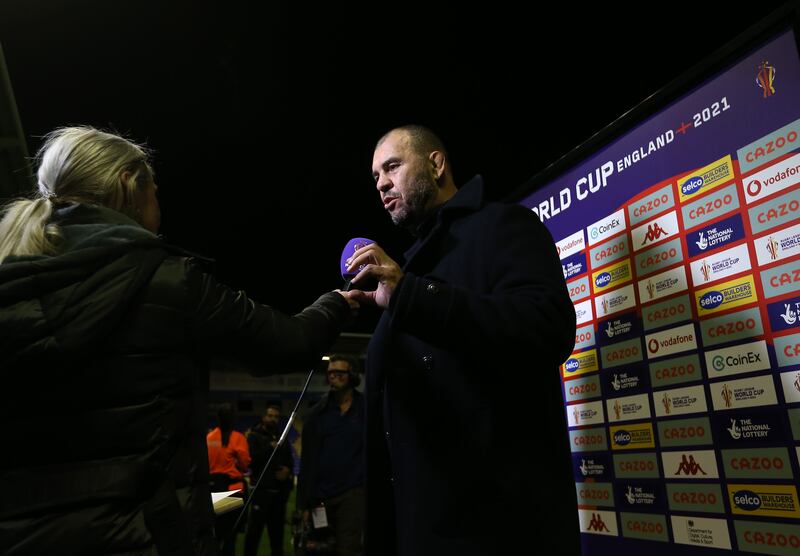How Ireland missed rugby’s first revolution is a long story. How the Irish sporting community has missed their national rugby league team, The Wolfhounds, currently competing in Rugby League’s World Cup is another.
In the 1890s English rugby was dominated by teams from northern England. Yorkshire and Lancashire were rugby’s powerhouses. Players from these working class areas, many of them coal miners, began to request, not unreasonably, that they be compensated by their rugby clubs for missing work shifts due to injuries sustained while playing.
Even though the majority of rugby clubs were from the north, the Rugby Football Union (RFU) committees were dominated by the aristocrats based in London and the south.
Hiding behind the curtain of the mythical Corinthian spirit, while in reality wanting to maintain the divide enshrined in their Empire’s class structure, the RFU refused a single penny in compensation. Fairness and compassion are not words we associate with the British Empire’s tyrannical past.
READ MORE
In 1895, after the southern-dominated RFU suspended several northern clubs from the competition for providing compensation to injured players, 22 clubs from northern England broke from the RFU and formed the Northern Union.
The battle for compensation boiled over in Sydney in 1908. The New South Wales Rugby Union was as pigheaded as their English brethren and the New South Wales Rugby League came into being. They soon kicked flankers out and the 13-a-side game was born.
In Australia, the split was a civil war. The dislocation within the rugby community created divides that still exist to this day.
Clubs literally split in two. Western Suburbs Rugby Club in Sydney, where I played a large part of my career, is a classic example. In 1908 half of the Wests players stayed with rugby and the other half took the club’s name, jersey and crest and set up at another field a few kilometres away.
Bitter does not even get close to describing the animosity. Best friends never spoke to each other again. Families were torn apart as brothers, sons and fathers were alienated from each other, sometimes for life.
Wallabies had their photos taken down from clubhouse walls and their names scratched from honour boards. Any rugby union player who walked onto a league pitch was banned for life.
Early in 1995 I coached Balmain Rugby League’s 7s team during a weekend tournament in Sydney. At the time I was working for the New South Wales Rugby Union. Even though I was not paid, I had unwittingly crossed a line. My boss had to do a lot of sweet talking to stop me from being banned.
The rugby codes have endured more than a century of animosity, all because players were not compensated for time away from their work because of playing the game. Ironically, this was the exact reason why, six months after I was threatened with a life ban, professionalism came into rugby.
My own dealings with the codes were far more simple. Both of my parents had cousins and uncles who had played rugby league at a high level, while my grandfather, father and uncle had all played club rugby. From birth, my brothers and I had a foot in both camps. Like all my schoolmates, we were brought up playing and watching both codes. Saturday was rugby. Sunday was Rugby League.
Having played and coached in both codes, I have witnessed unbelievable ignorance and bigotry from both sides. What I found is that there are lots of great human beings and a few supreme, and pardon my French, d**kheads in both codes.
Last weekend the Rugby League World Cup returned to its roots when the first matches were played across northern England.

League’s heartland remains the east coast of Australia and England’s north. While it is still played in pockets of southern France, it is the lure of Australia as a destination for migrants and the quality of the Australian National Rugby League (NRL) that has generated a huge reservoir of talent that supplies the majority of international league teams.
No greater example of the power of the many diasporas in Australia than former Leinster, Wallaby and current Puma rugby coach Michael Cheika, who is coaching Lebanon, the country of his parents’ birth, at the this World Cup.
Known as The Cedars, the Lebanese team are a talented group of Australian-born, ethnic Lebanese who, like Cheika, have parents or grandparents born in Lebanon. The passion on display when the Cedars play for their ancestral home is truly inspiring.
The Wolfhounds are following the same course.
Irish Rugby League has identified over 40 eligible players currently playing in the NRL system. These talented young players are being monitored for selection in the next World Cup to be held in France in 2025. Recently an U18 team, selected from the Australian Irish diaspora, represented Ireland and competed in an NRL tournament.
More than a decade ago I urged the IRFU to establish an academy in Australia to tap into the huge Irish population that had migrated to New Zealand and Australia during the global financial crisis. Irish Rugby League is now a step ahead.
In Ireland, league is a cross Border sport with eight men’s clubs operating across the island. Women’s teams have also been established and while there is only one junior rugby league club, they make up for the lack of numbers with the gorgeous name, The Loughshinny Foxes.
Rugby League in Ireland and Britain is a summer sport. So league is not in competition with rugby, nor is it a threat but it is a great opportunity for Irish rugby players to learn.
League is a simpler game than rugby, with no contest for possession at the tackle, in other words, no messy rucks, so it produces far fewer penalties. This means the ball is in play for upwards of 75 minutes, making league a lung-busting aerobic monster.
When you play league you learn three things. Firstly you are taught to tackle with precise techniques because with no lineouts, mauls or real scrums there are a lot of attackers that have to be tackled.
In attack, players are coached on how to run effective attacking lines that exploit the defenders’ weaker shoulder positions. Importantly, league offers what has been robbed from creative players in rugby. That is time with the ball in hand. With only 13 players on the field and the defenders back 10 ten metres, creative attackers have time to run at the defence and scan the line searching for opportunities.
For young developing players, experiencing league is a great learning tool. Playing multiple sports like league and GAA at a young age makes for better rugby players. In turn, playing rugby or league will make GAA players far more comfortable with physical contact.
The Wolfhounds are proudly representing Ireland with a team compiled of players from Ireland’s UK and Australian diaspora. Players whose parents or grandparents were born in Ireland.
Coached by the Irish-born Jed Corcoran, who played for Halifax in Super League, like the 1895 revolution itself, the Wolfhounds competing at the World Cup seems to have slipped under the Irish rugby public’s radar.
The Wolfhounds top playmaker is Luke Keary. From the Sydney City Roosters, he is playing for Ireland via his father’s Galway family.
A product of Sydney’s tight-knit rugby community, I have been watching Luke play since he was a boy, as my nephew played in the same schoolboy rugby team. Keary’s decision to play professional league was a great blow to Australian rugby. There is a high probability that if he stayed he would have worn the gold Wallaby number 10 jersey.
Keary has represented Australia in league but, under their progressive rules, players who represent the country of their birth can later play for the country of their ancestral heritage. It’s a rule that has enabled teams from the Pacific nations, Jamaica, Lebanon and Ireland to grow in stature.
It is an excellent policy that rugby has recently adopted.
As someone born in the Irish diaspora it is exceptionally difficult to express to people born on the island of Ireland the notion of being two nationalities. So difficult that I have stopped trying.
To those born in the new world countries like America, Canada and Australia, the concept of being Lebanese Australian or Irish Australian is completely natural because that is who have been for your entire life.
Recently Michael Cheika tried to express the concept when he said: “To represent the country where your parents were born is a great opportunity. Coaching a team that my dad, mum, the country they were born in, is something I never thought I’d get a chance to do, and I want to make sure that I do the best I can so that people can be proud of what happens on the field.”
In a twist of fate only sport could produce, tomorrow the Irish Wolfhounds take on Cheika’s Cedars. Not only is the World Cup worth watching for its entertainment value but the Wolfhounds are a team worthy of Irish support.
















